|
|
Print this review
Windows Mobile at 3GSM Congress
A month ago the market of smartphones and communicators running on Windows Mobile was absolutely quiet – even with 3GSM Congress approaching most manufacturer didn’t hold press-conferences. And there was a plain reason for that – they were all holding the breath, waiting for the new Windows Mobile version, to release new solutions on the same day with the OS (for the most part the introduced devices are based on the WM 6). So, already on Monday details on novelties delivered by HTC, Asus, HP, i-Mate, Toshiba started to spring as out of the horn of plenty. By that day’s evening there was literally a pile of announcements so big, that is was difficult to sort it out. And today we have all the rights to state that most companies actually managed to generate some hype.
This article continues the series of digests at Mobile-review.com devoted to all happenings taking place at 3GSM Congress in Barcelona. Like my colleagues I will share with you not only facts and information available to date, but also my personal feelings and predictions on specific models. Now on to the point.
HTC
Previously this communicator was codenamed HTC Athena; as regards its positioning, whether it will be presented as a UMPC or a tablet computer – it is still to be determined. A bit earlier we published a preview on HTC Athena, so now allow us to dwell upon its specifications and the highlights it brings to the table. It is remarkable that a few days prior to 3GSM Congress commencement, www.seehtc.com was launched on the Net, where one could find a timer counting down days to the official announcement of the novelty. Now this pages acts as a promo-site for HTC X7500.
-1.jpg)
Most of the specifications have remained untouched; therefore our readers who have been into this powerhouse won’t find this paragraph of much use. The communicator runs on Windows Mobile 5.0 Pocket PC Phone Edition. Check out its brief spec sheet below:
- GSM/GPRS/EDGE (850/900/1800/1900 MHz), UMTS/HSDPA (2100 MHz for Europe, 850/1900 MHz for the US)
- 5-inch touch display with VGA resolution (640x480 pixels)
- 3 Mpix auto-focus enabled camera with flash
- VGA-camera
- Detachable QWERTY-keyboard
- GPS-module
- Intel PXA270 624 MHz CPU, ATi W2284 graphics accelerator
- 128 Mb of RAM and 256 Mb of flash-memory
- 8Gb hard drive
- miniSD memory expansion slot
- Bluetooth 2.0, Wi-Fi (802.11 b/g)
- HTC ExtUSB, proprietary HTC socket with VGA/TV-out
- 2200 mAh Li-Ion battery
- Talk time (with the display turned off) - up to 5,5 hours (GSM) and 4,5 hours (UMTS)
- Standby time - up to 300 hours
- Dimensions - 133,5x98x16 mm, with keyboard - 20 mm
- Weight - 359 grams
Judging by the provided data, on its release the X7500 will be beyond all competition – partly owing to the announced functionality that today looks like something out of this world, partly because HTC once again dared go against conventional trends of the communicators market and released the X7500.
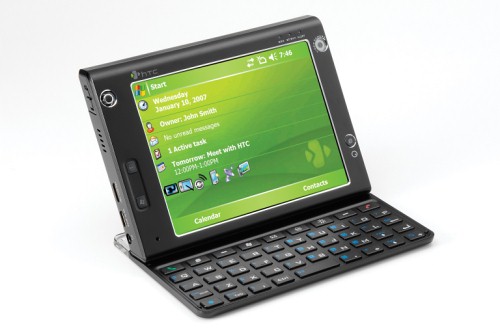
Speaking on the outlook for handset’s fate on the market is quite challenging, but we could do some guessing. Tablet computers, for example Origami, that was hyped so much by Microsoft, or Samsung’s own developments in this field (since Origami is manufactured by Samsung as well), prove to be utterly unpopular – in most cases, facing a dilemma over what to go for, consumers give preference to somewhat more pocketable alternatives. At the end of the day, for a device performing calls, being about half a kilogram heavy is way too much. The reasons and prerequisites for low demand are many – we have already mentioned them and give you some more insight into them once we get down to testing HTC X7500, and for the moment we can state that over HTC they don’t shun experimenting. In the end this policy not only does have a positive impact on HTC’s financial statement, but on the state of WM-market on the whole as well.
HTC S710
First gossips about smartphone armed with slide-out thumbboard codenamed VOX appeared a month before the official announcement, and since then there hasn’t been a day when they would be off. Much like HTC Athena’s case, the company plunged into a bold experiment initiating development of such device. This is actually one of the world’s first smartphones showing off both a numberpad and a sliding QWERTY-keyboard. Honestly, I can’t think of one too many counterparts among conventional handsets – thus HTC’s experiment does count for something in the world of mobile technologies. And particularly for HTC it is one of the first announced offerings that run on Windows Mobile 6 Standard.
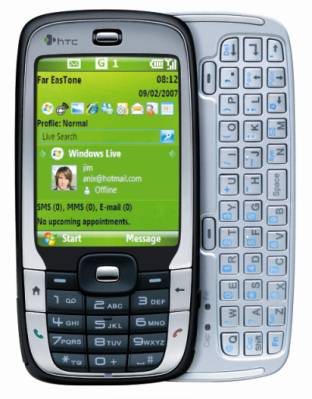
With the thumbboard closed, the S710 looks pretty much like any other candy-bar shaped phone dimensions-wise. To my mind, this aspect might be very decisive, tipping the scales in favor of HTC S710. At comparable size, the user gets two keyboards in one device, which is an extremely rare occasion on offerings by other vendors. Blackberry-esque devices, like HTC Excalibur, Samsung i600, Nokia E61 will lag behind the S710 simple because of the keyboard’s real estate.

Specifications of the smartphone won’t blow you away, yet for such a device being a powerhouse is not a must.
- GSM/GPRS/EDGE (850/900/1800/1900 MHz)
- 2.4-inch TFT-display with QVGA resolution (240x320 pixels)
- 2 Mpix CMOS camera
- Sliding QWERTY keyboard
- TI OMAP 850 CPU running at 200 MHz
- 64 Mb or RAM and 128 of flash-memory
- microSD memory expansion slot
- Bluetooth 2.0, Wi-Fi (802.11 b/g)
- 1050 mAh Li-Ion battery
- Talk time – up to 7 hours
- Standby time – 175 hours
- Dimensions – 101.5x50x18.6 mm
- Weight – 140 grams
HTC P3350
This communicator is an exact replice of HTC P3300 (Artemis). The only differences lie in slightly altered design (these regard only particular elements and the trim) and absence of a bundled GPS-module in HTC P3350 – instead it packs more flash-memory. The P3350 is powered by Windows Mobile 5.0 Pocket PC Phone Edition.

HTC P3350 specifications aren’t different from those of HTC P3300:
- GSM/GPRS/EDGE (850/900/1800/1900 MHz)
- 2,8-inch display with QVGA resolution QVGA (240x320 pixels)
- 2 Mpix camera
- FM transmitter
- TI OMAP 850 CPU running at 200 MHz
- 64 Mb of RAM and 256 Mb of flash-memory
- microSD memory expansion slot
- Bluetooth 2.0, Wi-Fi (802.11 b/g)
- HTC ExtUSB socket
- 1200 mAh Li-Pol battery
- Talk time - 3,5-4 hours
- Standby time - 150-200 hours
- Dimensions - 108x58x16,8 mm
- Weight - 130 grams
On the face of it, marginal revamp of Artemis is not a justified step. On the other hand, HTC P3300 is all the rage nowadays, which comes as no surprise, however, due to it being one of the most pocketable keypad-less communicators to date. Removal of the GPS-module and hence of a good half of the sales package (for the P3300 it includes car holder and CD with TomTom Navigator) had a positive impact on the retail price. The updated model is capable of forging into the lead in its segment thanks to popularity and portability of HTC P3300 and reduced price, compared to the P3300.
HTC P3400
A classic communicator lacking a thumbboard – no full spec sheet is available yet, however the core aspects are akin to HTC P3350, saving for less flash-memory volume and different design. As soon as we get more information on the P3400, we will definitely come back to look at it a bit closer.
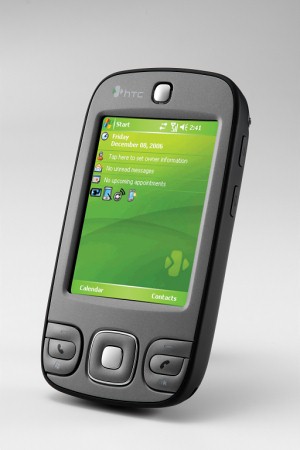
ASUSTeK
As of today, the company hasn’t managed to build up a name for itself on the Russian market, yet has already made a statement with a number of successful offerings. At 3GSM Congress ASUS showcased a couple of new solutions running on Windows Mobile 6. Also some news started spreading around regarding the fact that the company is getting ready to come up with a firmware to update some already existing solutions to WM 6.
ASUS Aries
With the announcement of this model ASUSTeK signs up for a race for a new segment that has been initiated not so long ago with the advent of Nokia E61, HTC Excalibur etc. With this offering ASUS gives a QWERTY-armed smartphone a good go. In terms of dimensions and design the device willy-nilly seems modeled after its rivals, which is in fact the design philosophy of this form-factor. Detailed specifications for the model are not available yet, however there definitely will be much of a punch crammed inside, just like we have come to expect from the company’s proposals - XScale CPU running at 520 MHz is one more proof of that. Plus we will get a 2 Mpix camera and UMTS support with it.
It is worth mentioning that ASUS devices have always boasted excellent build quality, similar to that provided by HTC – all this is due to that fact that the company produces its solutions on its own.
Toshiba
The Japanese company, which is a new player to the communicators market, presented at the Congress two interesting devices at once. In spite of the fact, that some features of these devices have already appeared on their official page it is quite difficult to define whether they should be placed among smartphones or communicators. It is also difficult to say if the company going to supply Russian market with these offerings.
PORTEGE G500
A smartphone based on Windows Mobile 5.0 (there is no reliable information on whether the phone belongs to smartphones) and housed in the slider-style form-factor. As for the main highlight of the device, the company points out the following one: «…This quality and compact slider phone uses fingerprint technology to protect the data stored on the handset.…» The smartphone works both in GSM and UMTS networks and offers Wi-Fi wireless connectivity. Support for miniSD memory cards is also available.
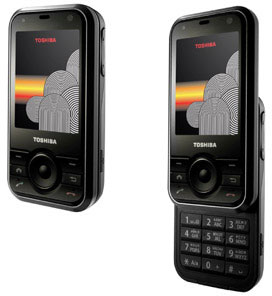
If the device arrives in Russian market this particular event will prove to be quite interesting. I wonder what methods the company will choose for promoting new WM-powered devices. For the time being, we can note unusual for such devices form-factor. In fact fingerprints identification feature didn’t stand a test on the Russian market once; perhaps Toshiba will manage to make it more relevant, since if the company managed to get enterprise users involved, this idea could find application in certain fields.
PORTEGE G900
This is a communicator employing already widely spread thumbboard-armed side-slider form-factor. I will take the risks of supposing that this model will encounter certain difficulties in the Russian and all other markets as well. The main reason for this is saturation of this very segment as today users can turn their eyes to an incredibly wide range of side-sliders with QWERTY-keyboard. As for the newsworthy highlights of PORTEGE G900, these are: display with a 3-inch diagonal and W-VGA (800x480 pixels) resolution, USB-HOST function, HSDPA technology support and an ability to identify fingerprints. The G900 runs on Windows Mobile 6 Professional.
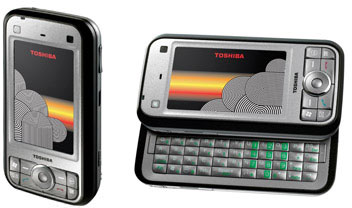
By the moment the communicator will have arrived in the market, other manufacturers might already have update editions of already existing solutions, which will only increase competition in this field.
i-Mate
The company is going through a hard time – ever since HTC has begun developing its very own brand, over at i-Mate they have been looking for a new manufacturer to team up with. And all new proposals delivered by i-Mate, after breaking up with HTC, regrettably, left much to be desired. Specifically, these gripes had much to do with the build quality and consequentially the design. At present the company is seeking after a new maker and there is a good chance that the devices introduced at 3GSM Congress will be produced by a large and reliable Taiwanese vendor, which would allow addressing build quality issues. The activity of i-Mate at the Congress is incredibly high – in the sense of announced novelties the company is in one boat with manufacturers of conventional phones (Nokia, Samsung).
The truth is, there are some stand-alone models, but the rest of the newcomers to the company’s range belong to one line-up, sharing style and approach in common. Let us examine i-Mate’s offerings a tad closer.
i-Mate JAQ4
After the release of the barely successful JAQ3, the company comes up with its successor. It is significant that there is only a tiny time gap separating these two offerings and as a matter of fact they are close relatives functionality-wise. So the JAQ4 is nothing else but a QWERTY-equipped smartphone joining the line of HTC Excalibur-, Nokia E61-esque proposals. Fundamental differences include bundled GPS-received, brand-new WM 6 operating system and touch display.
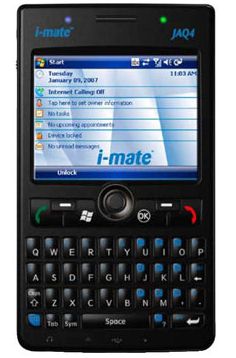
The smartphone delivers pretty much standard specifications:
- GSM/GPRS/EDGE (850/900/1800/1900 MHz)
- 2,8-inch touch display
- 2 Mpix auto-focus enabled camera
- 64 mb of RAM and 128 Mb of flash-memory
- TI OMAP 850 CPU running at 200 MHz
- miniSD memory expansion slot
- QWERTY-keyboard
- GPS-module
- Wi-Fi (802.11 b/g), Bluetooth 1.2 (A2DP) and IrDA
- 1660 mAh Li-Ion battery
- Talk time- up to 5 hours
- Standby time - up to 200 hours
- Dimensions - 125x71x15,5 mm
- Weight- 184 grams (battery included)
Among everything else we should point out a capacious battery, whose 1660 mAh at such a moderate CPU should keep the device up and running for quite a while. On the negative side, the JAQ4’s dimensions and weight might prove to be a hassle, since its size coupled with angular design leaves the impression of an awkward device.
i-mate Ultimate
i-Mate released its new series under the tagline of “Ultimate” – one of the new line’s highlights is Intel CPU running at 520 MHz, which might has served as the base for the entire range’s name. Ultimate includes five Windows Mobile 6 based devices that share in common only powerful hardware, but also design edges and curves. Within the line-up the offerings have the following digital indexes: 5150, 6150, 7150, 9150, 8150.

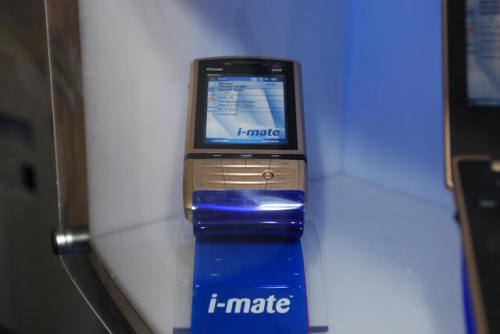
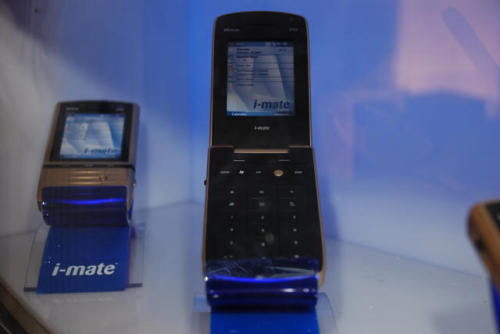
i-mate Ultimate 5150
Software on all phones has undergone remarkable changes, which is all another step on the way to better functionality. Let’s look into the key aspects and try to evaluate them.

The communicator housed in the slider-style form factor was introduced in course of the opening day and attracted great attention back then – in the first place with its specifications. As mentioned above, all Ultimate solutions are powered by Windows Mobile 6, and the rest of data on the spec sheet is worth looking at:
- GSM/EDGE, UMTS/HSDPA
- Intel Bulverde 520MHz CPU
- 128 Mb of RAM and 256 Mb of flash-memory
- microSD memory expansion slot
- TFT touch display with VGA resolution (640x480 pixels)
- Bluetooth 2.0 + EDR, Wi-Fi 802.11b/g/e/i
- Direct Video Out XGA
- 2 Mpix camera
- FM stereo-radio
With such specifications announced, it is not a big deal to figure out why the series got so many eyes watching on it. The company has slotted the launch for the beginning of Q3 of 2007. Here we should again turn our sight to the current market position of i-Mate – in case it manages to team up with a reliable manufacturer that would provide it with required amount of units and production speed, then by the end of 2007 i-Mate not only might turn the situation around, but also jump into the leading group.
HP
The American brand also suffered from the “reduction” held by HTC, which led to a short period of silence, when HP kept low profile and didn’t present the market with announcements. As of today, the company is running a joint venture with Quanta Computer and has already released iPAQ 68xx series with the help of this Taiwanese vendor.
At 3GSM HP launched something not like it at all – a smartphone running on Windows Mobile 6.
HP iPAQ 510
This smartphone employs candy-bar shape and is in fact the first representative of iPAQ 500 Series Voice Messenger. The model is due out in Russia in summer, 2007. For all offerings belonging to the series the specifications are as follows:
- GSM/GPRS/EDGE (850/900/1800/1900 MHz)
- 2-inch display with a resolution of 176x220 pixels
- TI OMAP 850 CPU at 200 MHz
- 64 Mb of RAM and 128 Mb of flash-memory
- microSD memory expansion
- Wi-Fi (802.11 b/g), Bluetooth 1.2 è USB 1.1
- 1100 mAh Li-Ion battery
- Talk time - up to 6,5 hours
- Standby time - up to 188 hours
- Dimensions - 107x48,6x16,3 mm
- Weight - 102 grams
Among all other things, we can’t overlook nearly dated screen resolution (176x220), and USB 1.1 interface. On the other hand the device is positioned as a smartphone for work purposes, so it is not about data transfer speed, especially between a desktop PC and the smartphone.
HP’s trademark design has always been undeniable – austere style on the verge of antique. Much like notebooks and PDAs made by the company, the new series of smartphones is no-nonsense, meaning that smooth edges, accurate lines and black color bring you back to the times when smartphones were still bulky and awkward. But for HP this style doesn’t look like a relic and is taken as the company’s trademark feature.
But on the whole it is not particularly clear what the company aims for – on the one hand it tries to keep abreast of the times, releasing a series of smartphones that are all the rage today, but at that the specifications and abilities of the first device are more than unpretentious, as they rely mostly on the brand awareness.

Gigabyte
The Taiwanese manufacturer dealing with PC peripherals and, since recently, with mobile gadgets as well, has come with two new solutions at 3GSM Congress
GSmart t600
This communicator bases off Windows Mobile 6 Professional, works in GSM networks and sports the ability to receive TV signal (little by little this feature is becoming the trait of all Gigabyte-branded solutions). The following standards are supported: DVB-H, DVB-T, T-DMB and DAB, at that the device comes equipped with telescopic antenna. XScale CPU running at 520 MHz, 96 Mb of RAM and VGA resolution on a 2.6-inch display stand out on the t600’s spec sheet. At such ratio between the physical size and resolution, the picture put on by Gsmart t600’s display should be ultra-crisp.
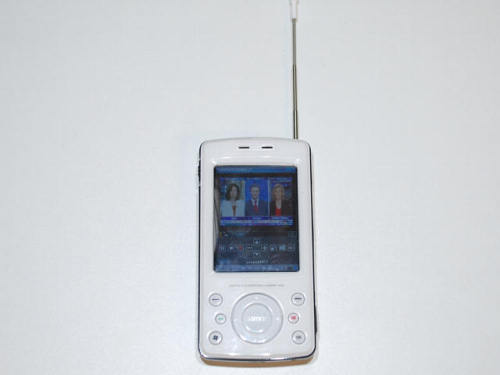
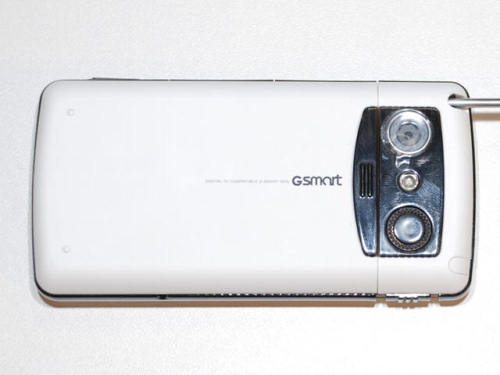
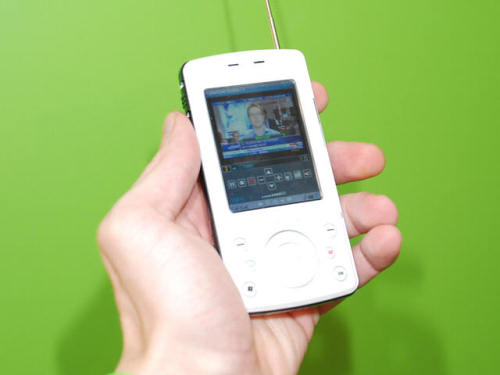
GSmart q60
Another WM 6 Professional-powered communicator, this time around it is thumbboard-armed, and hence has got horizontally-orientated display. The q60 works within GSM and UMTS networks, boasts a GPS receiver onboard and supports digital TV.
Bluetooth and Wi-Fi wireless connectivity options are embedded in both models.
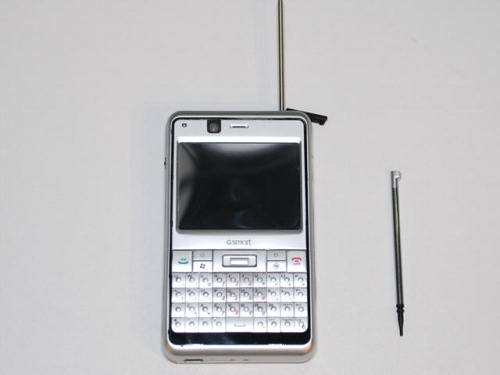

Apart from the aforementioned manufacturers, many other companies announced loads of WM-based solutions. Specifically, Motorola revamped its Q series (read more in our «Motorola at 3GSM Congress» digest), Lenovo came up with two products running on WM, and also there was a BENQ Siemens branded smartphone. No word on these solutions yet – all we can do for now is present you with some photos.

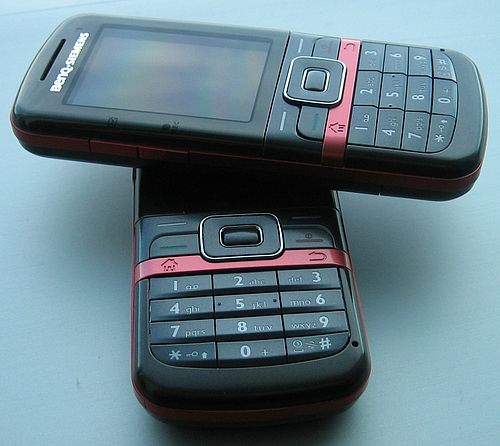
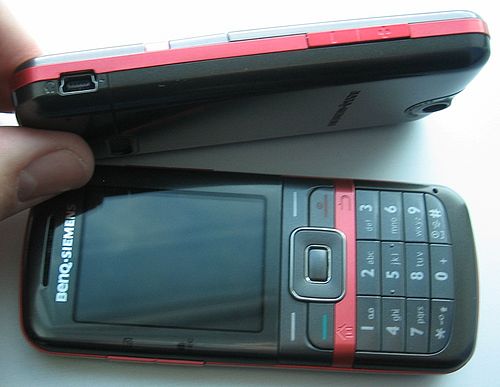
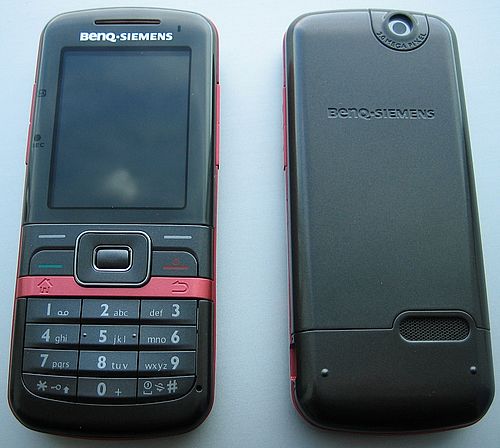
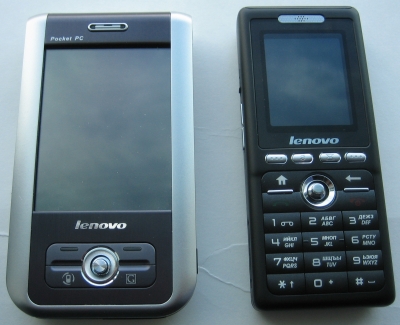
Related links:
Artem Lutfullin ([email protected])
Translated by Oleg Kononosov ([email protected])
Published — 19 February 2007
Have something to add?! Write us... [email protected]
|
News:
[ 31-07 16:21 ]Sir Jony Ive: Apple Isn't In It For The Money
[ 31-07 13:34 ]Video: Nokia Designer Interviews
[ 31-07 13:10 ]RIM To Layoff 3,000 More Employees
[ 30-07 20:59 ]Video: iPhone 5 Housing Shown Off
[ 30-07 19:12 ]Android Fortunes Decline In U.S.
[ 25-07 16:18 ]Why Apple Is Suing Samsung?
[ 25-07 15:53 ]A Few Choice Quotes About Apple ... By Samsung
[ 23-07 20:25 ]Russian iOS Hacker Calls It A Day
[ 23-07 17:40 ]Video: It's Still Not Out, But Galaxy Note 10.1 Gets An Ad
[ 19-07 19:10 ]Another Loss For Nokia: $1 Billion Down In Q2
[ 19-07 17:22 ]British Judge Orders Apple To Run Ads Saying Samsung Did Not Copy Them
[ 19-07 16:57 ]iPhone 5 To Feature Nano-SIM Cards
[ 18-07 14:20 ]What The iPad Could Have Looked Like ...
[ 18-07 13:25 ]App Store Hack Is Still Going Strong Despite Apple's Best Efforts
[ 13-07 12:34 ]Infographic: The (Hypothetical) Sale Of RIM
[ 13-07 11:10 ]Video: iPhone Hacker Makes In-App Purchases Free
[ 12-07 19:50 ]iPhone 5 Images Leak Again
[ 12-07 17:51 ]Android Takes 50%+ Of U.S. And Europe
[ 11-07 16:02 ]Apple Involved In 60% Of Patent Suits
[ 11-07 13:14 ]Video: Kindle Fire Gets A Jelly Bean
Subscribe
|
-1.jpg)























